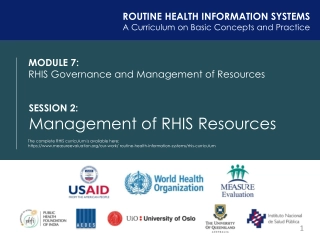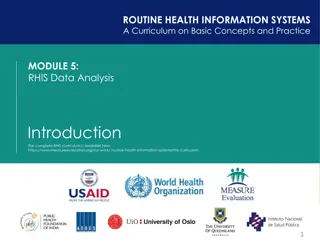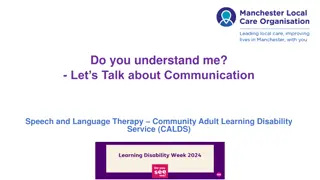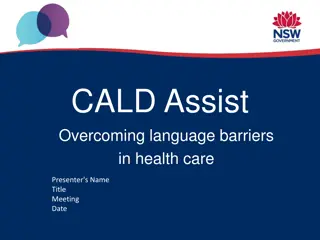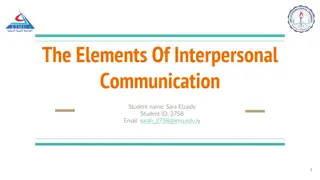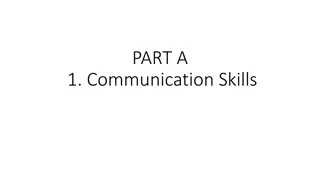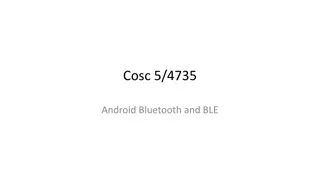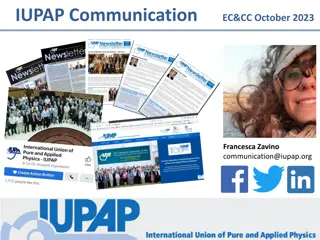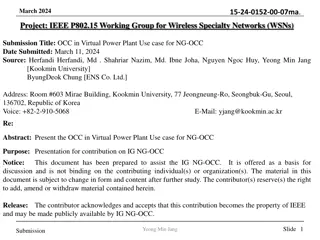Basic Concepts and Practice of Information and Communication Technology for RHIS
This module is part of the RHIS curriculum and focuses on providing a solid foundation in Information and Communication Technology for Routine Health Information Systems. It covers key concepts and practical applications to enhance data management and communication within the healthcare system.
Download Presentation
Please find below an Image/Link to download the presentation.
The content on the website is provided AS IS for your information and personal use only. It may not be sold, licensed, or shared on other websites without obtaining consent from the author. Download presentation by click this link. If you encounter any issues during the download, it is possible that the publisher has removed the file from their server.
Presentation Transcript
ROUTINE HEALTH INFORMATION SYSTEMS A Curriculum on Basic Concepts and Practice MODULE 8: Information and Communication Technology for RHIS Introduction The complete RHIS curriculum is available here: https://www.measureevaluation.org/our-work/ routine-health-information-systems/rhis-curriculum 1
MODULE 8: Learning Objectives By the end of this module, participants will be able to: Explain key terms used in eHealth and mHealth (the use of ICT in health systems) Discuss how application architecture fits in the overall enterprise architecture (EA) Describe the role of ICT in integration and interoperability of RHIS Explain the importance and application of patient-centered information systems Explain definitions and concepts of data repositories and data warehousing 2
MODULE 8: Structure Duration: 6 hours Number of sessions: 4 Session 1: eHealth, mHealth, and HIS Enterprise Architecture (2h) Session 2: RHIS Integration and Interoperability (1h30min) Session 3: Patient-Centered Information Systems (1h) Session 4: Data Repository/Data Warehouse (1h30min) 3
Module 8: Suggested References Digital Development Principles Working Group. (n.d.) Principles of digital development (Website). Retrieved from http://digitalprinciples.org/. HIMSS. (2013). HIMSS board-approved definition of interoperability [Website]. Retrieved from http://www.himss.org/ResourceLibrary/genResourceFAQReg.aspx?ItemNumb er=23990 Ritz, D., Althauser, C., & Wilson, K. (2014). Connecting health information systems for better health: leveraging interoperability standards to link patient, provider, payer, and policymaker data. Seattle, WA: PATH and Joint Learning Network for Universal Health Coverage. Retrieved from http://www.jointlearningnetwork.org/resources/connecting-health- information-systems-for-better-health. Sandeep, R. (2016). An introduction to user centered design (Website). Retrieved from http://www.slideshare.net/rohansandeep/anintroductiontoucd. 4
Module 8: Suggested References Stansfield, S., Orobaton, N., Lubinski, D., Uggowitzer, S., & Mwanyika, H. The case for a national health information system architecture: a missing link to guiding national development and implementation. Retrieved from https://www.hingx.org/Share/Details/986. Usability First. (n.d.) Introduction to user-centered design (Website). Retrieved from http://www.usabilityfirst.com/about-usability/introduction-to-user- centered-design/. Usability.gov. (2016). What and why of usability: user-centered design basics. Retrieved from http://www.usability.gov/what-and-why/user-centered- design.html. Web Accessibility Initiative. (n.d.) WAI website redesign project. Retrieved from https://www.w3.org/WAI/redesign/project.html. 5
ROUTINE HEALTH INFORMATION SYSTEMS A Curriculum on Basic Concepts and Practice This presentation was produced with the support of the United States Agency for International Development (USAID) under the terms of MEASURE Evaluation cooperative agreement AID-OAA-L-14-00004. MEASURE Evaluation is implemented by the Carolina Population Center, University of North Carolina at Chapel Hill in partnership with ICF International; John Snow, Inc.; Management Sciences for Health; Palladium; and Tulane University. The views expressed in this presentation do not necessarily reflect the views of USAID or the United States government. 6



